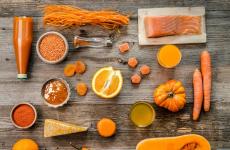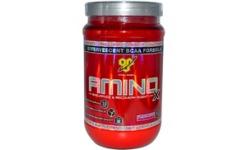Jackfruit is another name. Fruit jackfruit is a breadfruit! Harm of jackfruit and contraindications
A review article about jackfruit: what it is, where it grows, how the fruit is useful, taste, chemical composition and calorie content.
Jackfruit is the fruit of an evergreen tropical tree with dense oval leaves up to 22 centimeters in length, a powerful trunk of which can grow up to 20 meters. The fruits are very large and ripen from 3 to 8 months, but not on the branches, but directly on the trunk. Their size: the length of the small jackfruit is 20 cm, and the largest is 110 cm, the diameter is up to 20 cm, and the weight is up to 34 kg. Up to 500 seeds can be in one fruit. There is no doubt that this is the largest edible fruit growing on a tree.

In the photo there is a tree with jackfruit fruits
Botanical name - Artocarpus heterophyllus, like breadfruit, from the mulberry family, angiosperm division. The earliest jackfruit trees originated in Bangladesh and India. Now it is cultivated in Southeast Asia, East Africa, Brazil, the Philippines, Thailand. Their popularity is comparable only to bananas and mangoes. The fruit of the plant is nutritious, available to everyone where it grows (cheap), does not require special preparation, because of this it can be called “bread for the poor”.
Attention, just do not confuse it with a similar, also one of the largest fruits in Asia -.

Outwardly, a large fruit is an oval jackfruit, with a pimpled skin of a light brown, yellowish or green color - it depends on the variety. Inside it contains many lobules of yellow or orange color with a stone. From what variety of jackfruit you eat, the slices themselves will be either crunchy, or soft or even very soft, or viscous like rubber. The taste is also a lot of variety: the pulp is pleasantly berry, chocolate, ruminant-vanilla ... In general, sweet! Interestingly, the ripe fruit smells disgusting, like rotten onions, but its pulp is fragrant like pineapple or banana.
The local cuisine has many recipes for making jackfruit. If the fruit is ripe, then it is consumed fresh, crumbled into a salad, dessert dishes. But immature ones are cooked like a vegetable - they are stewed, boiled, fried, etc., even used as a filling in pies. The seeds are also edible - they are fried and eaten.
Those who like to eat very sweet overripe fruits need to know that such jackfruit will soon turn brown and go bad. To keep it fresh, put it in the refrigerator (freezer), where it can be stored for up to 2 months.
On a note: the jackfruit plant itself, the fruit and each part of it individually contain sticky latex. And if you bought the whole fruit, then it is better to cut it with gloves or pre-grease your hands with vegetable oil.
Choose like this: if you need an unripe jackfruit, it will make a dull sound when tapped. If you want ripe, then the sound will be hollow, sonorous. The peel is also different: in ripe ones it is dense, elastic, but no longer firm.
Cut into food: cut this large oval fruit lengthwise, remove the resin, the core and press on the peel, separating all parts of the jackfruit from each other. With the help of a knife, the sweet pulp is cut out and the seeds are selected.
Video how to cut jackfruit:
Jackfruit chemical composition and calorie content
The ripe fruit has a pleasant sweet taste and is very nutritious. It contains vitamins, micro- and macroelements, a lot of carbohydrates. Another name for jackfruit is Indian breadfruit.
In the photo peeled slices of jackfruit pulp
Calorie content of jackfruit - 94 kcal per 100 g, the same amount of fresh fruit pulp contains:
- Protein - 1.46 g
- Fat - 0.29 g
- Carbohydrates - 2.4 g
- Saturated fatty acids - 0.062 g
- Dietary fiber - 1.61 g
- Water - 73.2 g
- Ash - 1 g
- Beta-carotene vit. A - 15 mcg
- B9 - 14 mcg
- B6 - 0.11 mcg
- B2 - 0.1 μg
- B1 - 0.03 mcg
- Ascorbic acid vit. C - 6.68 mg
- - 0.4 mg
- Potassium - 300 mg
- Magnesium - 37.2 mg
- Iron - 0.58 mg
- Calcium - 33.9 mg
- Phosphorus - 36 mg
- - 3.1 mg
- Manganese - 0.2 mg
- Zinc - 0.4 mg
- Copper - 187 mcg
- Selenium - 0.59 mcg

Jackfruit contains a lot of useful elements, including vegetable fiber. It is not interchangeable for cleansing the intestines, removing toxins and normalizing the functioning of the entire gastrointestinal tract. For example, locals warn tourists who eat a lot of fruit pulp that it can cause diarrhea.
Vitamins A and C, folic acid and magnesium are good helpers of hematopoiesis. They nourish our capillaries and blood vessels, support vision.
From the pulp of this Indian breadfruit, healers of oriental medicine prepare medicines for pharyngitis, for stomach ulcers, to normalize digestion. If you believe the connoisseurs of all the properties of this tropical fruit, then you can avoid intoxication when drinking alcohol: before the feast, you need to eat the pulp of the jackfruit.
Contraindications
Individual intolerance to the product can be the reason for refusal to taste this nutritious and very sweet tropical fruit.
With a large amount of jackfruit pulp eaten, diarrhea can occur, and subsequently an upset stomach that requires treatment. It is better to start tasting the tropical fruit with small portions and gradually increase them.
Jackfruit belongs to the mulberry family. The plant is found in tropical climates of South (India, Bangladesh, Sri Lanka) and Southeast Asia (Philippines, Malaysia, Thailand, Indonesia), East Africa and Brazil. This fruit is especially popular in countries such as Jamaica, Trinidad and Tobago, Barbados.
It is safe to say that jackfruit is the record holder for the size of fruits, which reach a weight of 36 kg, a length of 90 cm and a diameter of 50 cm. Their thick yellow-green peel is equipped with thorns.
Ripe fruits are very sweet and tasty. To get to the edible part, you need to open the jackfruit and extract the bright yellow pods from the very core. By the way, unripe fruits with homogeneous green flesh can also be eaten.
In addition to its delicious exotic taste and aroma, reminiscent of the pungent aroma of a banana, jackfruit is endowed with useful properties. It is rich in important nutrients (vitamins A and C, calcium, potassium, iron, thiamine, riboflavin, folate, niacin, and magnesium).
Niacin is good for the skin and nervous system, and vitamin B6 lowers blood homocysteine levels (a relationship has been established between high homocysteine levels and cardiovascular disease).
And all these benefits are surprisingly low in calories: 94 calories per 100 grams of fresh produce.

Healing qualities
For immunity
Jackfruit is an excellent, albeit very exotic, source of vitamin C, which is famous for its antiviral and antibacterial properties, strengthens the immune system, and supports the activity of leukocytes.
From cancer
In addition to vitamin C, jackfruit is also rich in phytonutrients such as isoflavonoids, saponins and lignans with strong anti-cancer and anti-aging properties. These substances slow down cell degeneration, which can lead to degenerative diseases.
For digestion
Helps fight peptic ulcers and digestive disorders. The high fiber content of these fruits prevents constipation and helps cleanse the colon of chemicals.
For healthy skin and good vision
Contains Vitamin A, known for its benefits for the eyes and skin cells. It also prevents other vision-related problems such as macular degeneration and night blindness.
Natural energy drink
Along with many other fruits, it gives a person energy due to the presence of simple sugars (fructose and sucrose). However, it does not contain fats and bad cholesterol, which makes it an excellent source of strength.
Reduces blood pressure
Scientists have found potassium in jackfruit (approximately 300 mg per 100 g of product), which plays an important role in lowering blood pressure and reducing the risk of heart attack.
Strengthens bones
Rich in many minerals. One of them - magnesium (37 mg per 100 g of product), is involved in the absorption of calcium, which is very important for strengthening bones and preventing osteoporosis.
Prevents anemia
Iron (0.6 mg per 100 g of product), which these exotic fruits are rich in, prevents anemia and controls healthy blood circulation in the human body.
Benefits the thyroid gland
Copper plays a significant role in thyroid metabolism, especially in the production and absorption of hormones. It is good that jackfruit is literally "loaded" with this important micronutrient.
If you have the opportunity to introduce this exotic fruit into your diet (fresh, canned, dried or frozen), be sure to do it. Jackfruit is a great vegetarian meat substitute. No wonder its modification canned in sea water was nicknamed "vegetable meat".
Seeds hidden in sweet pods (bulbs) can be fried like chestnuts or boiled in water.
The root also has medicinal properties. Its extract treats fever, asthma and diarrhea, and when applied topically, it helps to cope with skin problems.
Jackfruit is an evergreen plant that will impress lovers of exoticism. The tree itself and the fruits growing on it bear the same name. The birthplace of the fruit is Bangladesh and India. But over time, it spread to other countries in Asia and Africa.
Jackfruit has a second name - breadfruit. The fruit is quite common due to its pleasant taste. Its taste has been compared to banana, mango or pineapple. But its dense skin has a very unpleasant aroma, reminiscent of rotting onions.
The breadfruit can grow up to 20 meters, its fruits are considered the largest and heaviest. One fruit can weigh up to 34 kg, while being up to 90 cm in size. Outwardly, the fruit resembles a melon with pimples. Its color depends on the degree of maturity, ranging from green (unripe fruit) to yellow-brown.
Jackfruit has an edible portion of yellow flesh and an outer rind. The juicy pulp has a delicate aroma and a bone inside. You should not cut the fruit with your bare hands, since the peel has a sticky substance that is not easily washed off.
Ripe fruit contains only 30–40% of the edible part, the rest is the peel. In India, the fruits are very cheap and are popularly called "bread for the poor."
Breadfruit consists mainly of carbohydrates, which contain 22.4 g per 100 g, which is 40% of the total mass. It has a very low protein content and even less fat. It also contains a high water content.
Jackfruit is also rich in vitamins, it contains vitamin C, as well as A, PP and group B.
Breadfruit also contains useful elements:
- potassium, the content of which is 303 mg per 100 g of product;
- magnesium;
- calcium;
- sodium;
- iron;
- copper;
- phosphorus;
- selenium;
- zinc;
- manganese.
The calorie content of jackfruit is quite low, only 90 kcal per 100 g of fruit. But at the same time, the fruit is very nutritious. Unlike bread, which it can easily compete with, jackfruit, which has a delicate taste, is able to get rid of excess weight. Jackfruit seeds, like the fruit itself, are also very satisfying.
Breadfruit is rich not only in fruits, but also in wood, the composition of which is not suitable for termites. Therefore, high-quality furniture and utensils are made from it.
Benefits of Jackfruit Fruit

The main advantage of the fruit is its nutritional properties. It contains more carbohydrates than bread, and fewer calories. Therefore, the use of the product is in its dietary qualities.
The beneficial properties of jackfruit have found their application in oriental medicine. There breadfruit is considered a medicine that can improve the functioning of the organs of the gastrointestinal tract. It is used against stomach ulcers, various digestive disorders.
The benefit of jackfruit is that it is the fruit of sobriety. It is suitable for those who need to keep their minds clear during the holidays. The fruit significantly reduces the effects of alcohol on the body.
The fruit is good for supporting immunity, and some believe that breadfruit can lower blood pressure. Some treat them for fever and also roast the seeds and use them as an aphrodisiac.
The harm of jackfruit can manifest itself if you eat an excessive amount of fruits. After all, they are laxatives with medium strength.
The roots of the tree, which help with problems with stool, have also found application, as well as flowers, which are used as an antidiuretic.
Eastern women drink decoctions from young foliage to increase the amount of breast milk.
Harm from tropical jackfruit

The fruit is contraindicated only for those people who have an individual intolerance or allergy to it and its components. But not everyone may know about it.
Overeating of the fetus can result in diarrhea or, in a more complex form, indigestion. Sometimes this can lead to serious problems that require treatment. But not always, large amounts of eaten fruit may be the cause. Organisms of people who are not accustomed to eating such food can also give the same failure. Therefore, the sweet and nutritious product should be tasted in small portions.
Jackfruit as a houseplant
Breadfruit can be propagated at home. Its seeds are seeds that must be planted immediately after eating the fruit, as they are not stored. The first shoots can germinate in 3–8 weeks. When the first leaves appear, the breadfruit must be transplanted into light, drained, moist soil. If you do this later, then the chances of damage to its root system increase significantly. The plant only tolerates light frosts.
To grow a tree at home, you need a large container for it. It is necessary to place the plant near heat and sunlight. To get enough light, you can use fluorescent lamps. You can feed the seedling with weak fertilizers to improve growth and development.
The use of breadfruit in cooking

The fruit can be eaten fresh, straight from the tree, and a variety of dishes can be prepared from it. For example, they make sweets from them: jelly, marmalade, they are simply candied. If the fruit is unripe, then it is cooked like ordinary vegetables - stewed, boiled or fried. Ripe slices can be frozen, they keep the taste for some time.
The seeds of the plant are also used for food, of which there can be up to 300 pieces in one fruit. Like chestnuts, they are also fried and eaten.
All the components of the tree go to food. The flowers are treated with boiling water and seasoned with shrimp sauce or flavor is added to hot pepper. Young foliage is an ingredient in papaya salad. The peel is pickled or given for food for animals.
Jackfruit is included not only in sweet dishes such as ice cream, pulp in coconut milk, fruit salads, pies, but also goes well with meat and fish. It is used to decorate dishes and add piquancy to them. Fried cubes of pulp are included in salads with chicken or vinaigrette.
As a side dish, the fruit is used after fried on the grill. They are also stuffed with poultry before cooking to give them an exotic taste.
Both the fruits and the trees on which they grow are called jackfruit. The homeland of jackfruit is India and Bangladesh. Gradually, these trees became more widespread, now they are grown in many countries of Southeast Asia, the Philippines, and even in Africa and northern Brazil.
Jackfruit is considered a close relative of the breadfruit but not so popular due to the unpleasant smell of the peel. After all, when the fruits are grown and harvested in large quantities, it becomes a rather serious problem. Nevertheless, jackfruit is quite common; in South Asia, it is comparable in popularity to mango or bananas. These trees are also grown for the sake of wood. These trees make excellent houses, furniture and household utensils, because termites do not eat it.
The plant itself can reach a height of 20 meters, and its dark green leathery leaves never fall off. An interesting sight is the blooming jackfruit. Larger flowers are located directly on the trunk, and small ones - on the branches. From the time of flowering to ripening of the fruit, it takes from 3 to 8 months. They are formed precisely closer to the trunk, because fragile branches cannot withstand the weight of massive fruits.
It is believed that the name of this plant comes from a distorted Indian word that means "big and round". Really, jackfruit fruits are the largest of all growing on trees... Their weight reaches 34 kg, the length can be from 20 to 90 cm. The fruit itself looks like a melon, but its thick rind has many protrusions, like pimples. The color of this fruit can be yellow-green or yellow-brown, unripe jackfruit is green in color.
The device of the jackfruit fruit is also interesting. Inside, it is divided into many lobes, covered with a leathery film. Each slice consists of a juicy yellow pulp and a seed, the length of which can be up to 4 cm. The pulp of the jackfruit has a pleasant delicate scent, reminiscent of a mixture of pineapple and banana. But the smell of the peel is not pleasant. It is said to resemble a rotten onion. When cutting jackfruit, you need to grease your hands with vegetable oil. The fact is that the peel contains a sticky substance, which will then be difficult to wash off. Some people prefer to peel the skin with gloves. In the refrigerator, jackfruit can be stored for up to 2 months, but in a warm place it deteriorates quite quickly.
Composition and calorie content of jackfruit
Jackfruit is a low-calorie product, about 90 kcal per 100 g of pulp... Due to its high carbohydrate content (22.4 g per 100 g) in India it is called “bread for the poor”. This fruit is very nutritious. Much less protein in jackfruit, and very little fat. But it contains a lot of water, dietary fiber, ash and saturated fatty acids. Of the vitamins, vitamin C takes the leading position, and the fruits also contain vitamins A, B1, B2, B6, B9 and PP. Jackfruit is very rich in potassium, per 100 g of pulp there are up to 303 mg of this mineral, there is also quite a lot of calcium, magnesium and phosphorus in it, there is sodium. Of the trace elements, jackfruit contains iron most of all, it also contains zinc, copper, manganese and selenium.
The benefits of jackfruit
The main value of jackfruit lies in its nutritional value.... As mentioned, it contains even more carbohydrates than bread. And at the same time, jackfruit contains much fewer calories than flour products. Therefore, it may well be called a dietary product.
In oriental medicine, jackfruit is used as a medicine.... Jackfruit pulp is used to treat pharyngitis, stomach ulcers and indigestion. In general, these fruits are useful for the functioning of the gastrointestinal tract, the fibers that they contain contribute to the normalization of the intestines. Also, this fruit helps to keep a sober head during feasts, reducing the effects of alcohol.
In Vietnam, jackfruit is used in oriental medicine. The pulp of the fruit helps with pharyngitis and other diseases. It also helps in the treatment of stomach ulcers and indigestion. Its fibers are beneficial for the functioning of the gastrointestinal tract. However, you should not eat this fruit in large quantities, because it has a laxative property of moderate strength. The fruits of jackfruit are also good because they help lower blood pressure and strengthen immunity. In some Asian countries, it is also used to treat fever. Roasted jackfruit seeds are also known to act as an aphrodisiac.
Not only the fruits are useful, but also other parts of this plant. For example, jackfruit roots are used to treat diarrhea, and the flowers of this plant are used as an antidiuretic. In the east, a decoction of jackfruit leaves is drunk by nursing mothers, this increases the amount of milk.
How do you eat jackfruit
Jackfruit is eaten both fresh and various dishes are prepared from it.... You can make jelly, marmalade or jam out of it. And if the fruits are unripe and have a green color, then they can be cooked like vegetables - boiled, fried, stewed, etc. Pies are made with unripe jackfruit, using it as a filling, or cut into cubes and baked. It is great as a side dish for meat and fish; it is also used as an ingredient in all kinds of salads and snacks. They can even be stuffed with chicken. Jackfruit wedges can be stored in the freezer for a long time. And its seeds are usually roasted like chestnuts. They are also very nutritious and healthy.
Jackfruit (Artocarpus heterophullus) is a tall evergreen plant, reaching up to 20 m. Belongs to the Mulberry family. It is a relative of the bread and fig tree. It bears the second name "Indian breadfruit". It has long, up to 25 cm oval, leathery, dark green leaves.
Flowers for women and men are formed on different inflorescences, outwardly inconspicuous, do not represent decorative value. When blooming, pale green, later darken. Ripening, they are covered with pollen, which falls off immediately after flowering.
The branches are thin, rather fragile, so the fruits are formed only on strong branches close to the trunk. Fruit ripening lasts 3-8 months. In the wild, the plant is pollinated by wind and insects. In culture, it is manually pollinated.

Jackfruit fruits are large, edible, 20-100 cm long, up to 20 cm in diameter, weighing up to 35 kg. The peel is thick, green, yellow-brown when ripe, covered with numerous bulges and tubercles. The pulp is yellow, fibrous, aromatic, smelling like a banana. Contains a large amount of seeds. The seeds and rind of the fruit smell unpleasant. Jackfruit tastes very sweet. All its parts contain viscous latex, so the fruit is cut with gloves. The shelf life of jackfruit in a cool place is 1-2 months. Overripe fruits spoil very quickly.
Spreading
The plant is native to the tropical rainforests of Western India. The tree is widespread throughout India, Southeast Asia, Central and East Africa, the Philippines, Brazil, Suriname, Bangladesh.
The jackfruit tree grows well in humid, tropical climates, and is thermophilic. At a temperature of -2, -4 ° C, the branches of an adult plant freeze slightly. Juveniles die if the temperature drops to 0⁰С.
Photo of jackfruit and the taste of its fruit
The jackfruit fruit is widely used in cooking. Unripe fruits are heat treated, fried, stewed, boiled. Ripe jackfruits are used fresh, they are used to make jelly, marmalade and other desserts.

Fruit should be eaten with a dense, intact, yellow-green or yellow-brown skin. The pulp should give off a pleasant, light aroma. A strong smell indicates that the fruit is overripe.

To peel the jackfruit, cut it lengthwise, then remove the sap and core. To separate the parts of the fruit from each other, you should press well on the peel. The pulp is cut out with a knife, after which the seeds are removed. Peeled fruit can be stored in the refrigerator for no more than 5 days. The seeds are fried and eaten like chestnuts. They contain fats, proteins and carbohydrates. The flowers of this tree are added to various sauces. The young leaves are used in salads.

The fruit of this culture is very nutritious. Its pulp contains up to 40% carbohydrates, which is more than bread, so the fruit in some countries is called "second bread" or "bread for the poor", the second name is explained by the low cost of jackfruit. 100 g of raw fruit pulp contains 95 kcal, canned - 92 kcal.
The wood of this tree is of great value for its resistance to the effects of fungi and termites, durability and a beautiful, golden brown hue. It is used in the construction of houses, in the manufacture of furniture, souvenirs, musical instruments. A natural yellow dye is obtained from the peel of the fruit and the trunk for dyeing silk and cotton. The latex contained in the pulp is used to make high quality glue.
Jackfruit at home
Jackfruit is propagated at home by seeds, which are planted immediately after the fruit is consumed. The seeds are not subject to storage. The sprouts appear in 3-8 weeks. The grown plant is transplanted when 4 leaves appear. It is rather difficult to transplant older seedlings without damaging the fragile root system.
Jackfruit grows well in well-drained, nutritious, light, moist soils. The plant does not tolerate stagnant water in the soil, like drought. Prefers sunny, wind-protected places. The culture is planted in a richly fertilized pit or compost heap. Abundant watering is necessary during the warm season. With the onset of cold weather, watering is reduced.






